Fault Zone Evolution and Development of a Structural and Hydrological Barrier: The Quartz Breccia in the Kiggavik Area (Nunavut, Canada) and Its Control on Uranium Mineralization
Abstract
:1. Introduction
2. Geological Setting
2.1. Regional Geological Setting
2.2. Local Geological Setting
3. Sampling and Methods
3.1. Drillhole Observations, Sampling Strategy and Collection of Oriented Data
3.2. Quartz Microscopic Characterisation by Optical and Cathodoluminescence Microscopy
3.3. Fluid Characterization by Trace Elements and Oxygen Isotopes Analyses
4. Results
4.1. Spatial Organisation and Macroscopic Characteristics of the QB
4.2. Microscopic-Scale Characteristics of the QB
4.3. Geochemical Signature of Quartz
4.3.1. Trace Element Concentrations
4.3.2. Oxygen Isotope Values
5. Interpretation of Results and Discussion
5.1. Origin and Nature of Silicifying Fluids
5.2. Fault Zone Processes Leading to the Formation of the QB: Cataclasis, Silicification and Hydraulic Brecciation
5.3. Evolution of the Fault Zone Properties though Time and Structural Control on Later Uranium Mineralization
6. Conclusions
Author Contributions
Funding
Acknowledgments
Conflicts of Interest
References
- Sibson, R.H.; Robert, F.; Poulsen, K.H. High-angle reverse faults, fluid-pressure cycling, and mesothermal gold-quartz deposits. Geology 1988, 16, 551–555. [Google Scholar] [CrossRef]
- Blundell, D.J.; Karnkowski, P.H.; Alderton, D.H.M.; Oszczepalski, S.; Kucha, H. Copper mineralization of the polish Kupferschierfer: A proposed basement fault-fracture system of fluid flow. Econ. Geol. 2003, 98, 1487–1495. [Google Scholar] [CrossRef]
- Micklethwaite, S.; Cox, S.F. Fault-segment rupture, aftershock-zone fluid flow, and mineralization. Geology 2004, 32, 813–816. [Google Scholar] [CrossRef]
- Cox, S.F. Coupling between deformation, fluid pressures, and fluid flow in ore-producing hydrothermal systems at depth in the crust. Econ. Geol. 2005, 100th Anniv. Vol, 39–75. [Google Scholar] [CrossRef]
- Muchez, P.; Heijlen, W.; Banks, D.; Blundell, D.; Boni, M.; Grandia, F. 7: Extensional tectonics and the timing and formation of basin-hosted deposits in Europe. Ore Geol. Rev. 2005, 27, 241–267. [Google Scholar] [CrossRef]
- Micklethwaite, S.; Sheldon, H.A.; Baker, T. Active fault and shear processes and their implications for mineral deposit formation and discovery. J. Struct. Geol. 2010, 32, 151–165. [Google Scholar] [CrossRef]
- Caine, J.S.; Evans, J.P.; Forster, C.B. Fault zone architecture and permeability structure. Geology 1996, 24, 1025–1028. [Google Scholar] [CrossRef]
- McCuaig, T.; Kerrich, R. P-T-t-deformation-fluid characteristics of lode gold deposits: Evidence from alteration systematics. Ore Geol. Rev. 1998, 12, 381–453. [Google Scholar] [CrossRef]
- Ridley, J.R.; Diamond, L. Fluid chemistry of orogenic lode gold deposits and implications for genetic models. Rev. Econ. Geol. 2000, 13, 141–162. [Google Scholar]
- Kolb, J.; Rogers, A.; Meyer, F.M.; Vennemann, T.W. Development of fluid conduits in the auriferous shear zones of the Hutti Gold Mine, India: Evidence for spatially and temporally heterogeneous fluid flow. Tectonophysics 2004, 378, 65–84. [Google Scholar] [CrossRef]
- Sibson, R. Earthquake rupturing as a mineralizing agent in hydrothermal systems. Geology 1987, 15, 701–704. [Google Scholar] [CrossRef]
- Sibson, R.H. Fault rocks and fault mechanisms. J. Geol. Soc. Lond. 1977, 133, 191–213. [Google Scholar] [CrossRef]
- Phillips, W.J. Hydraulic fracturing and mineralization. J. Geol. Soc. Lond. 1972, 128, 337–359. [Google Scholar] [CrossRef]
- Jébrak, M. Hydrothermal breccias in vein-type ore deposits: A review of mechanisms, morphology and size distribution. Ore Geol. Rev. 1997, 12, 111–134. [Google Scholar] [CrossRef]
- Laznicka, P. Breccias and Coarse Fragmentites: Petrology, Environments, Associations, Ores; Developments in Economic Geology Series; Elsevier Science & Technology Books: New Yrok, NY, USA, 1988; ISBN 9780444412508. [Google Scholar]
- Simmons, S.F.; White, N.C.; John, D. Geological characteristics of epithermal precious and base metal deposits. Econ. Geol. 2005, 100, 485–522. [Google Scholar]
- Zhong, J.; Pirajno, F.; Chen, Y.-J. Epithermal deposits in South China: Geology, geochemistry, geochronology and tectonic setting. Gondwana Res. 2017, 42, 193–219. [Google Scholar] [CrossRef]
- Goldfarb, R.; Christie, A.; Bierlein, F. The orogenic gold deposit model and New Zealand: Consistencies and anomalies. In Proceedings of the 2005 New Zealand Minerals Conference: Realising New Zealand’s Mineral Potential, Auckland, New Zealand, 13–16 November 2005; pp. 105–114. [Google Scholar]
- Cannell, J.; Cooke, D.R.; Walshe, J.L.; Stein, H. Geology, mineralization, alteration, and structural evolution of the El Teniente Porphyry Cu-Mo Deposit. Econ. Geol. 2005, 100, 979–1003. [Google Scholar] [CrossRef]
- Landtwing, M.R.; Furrer, C.; Redmond, P.B.; Pettke, T.; Guillong, M.; Heinrich, C.A. The Bingham Canyon Porphyry Cu-Mo-Au deposit. III. Zoned copper-gold ore deposition by magmatic vapor expansion. Econ. Geol. 2010, 105, 91–118. [Google Scholar] [CrossRef]
- Henderson, I.H.C.; McCaig, A.M. Fluid pressure and salinity variations in shear zone-related veins, central Pyrenees, France: Implications for the fault-valve model. Tectonophysics 1996, 262, 321–348. [Google Scholar] [CrossRef]
- Rusk, B.; Reed, M. Scanning electron microscope-cathodoluminescence analysis of quartz reveals complex growth histories in veins from the Butte porphyry copper deposit, Montana. Geology 2002, 30, 727–730. [Google Scholar] [CrossRef]
- Tóth, J.; Corbet, T. Post-Palaeocene evolution of regional groundwater flow systems and their relation to petroleum accumulations, Taber Area, southern Alberta, Canada. Geol. Soc. Lond. Spec. Publ. 1987, 34, 45–77. [Google Scholar] [CrossRef]
- Hiatt, E.E.; Palmer, S.E.; Kyser, K.; O’Connor, E.; Terrence, K.H. Basin evolution, diagenesis and uranium mineralization in the Paleoproterozoic Thelon Basin, Nunavut, Canada. Basin Res. 2010, 22, 302–323. [Google Scholar] [CrossRef]
- Reynolds, R.L.; Goldhaber, M.B. Origin of a South Texas roll-type uranium deposit; I, Alteration of iron-titanium oxide minerals. Econ. Geol. 1978, 73, 1677–1689. [Google Scholar] [CrossRef]
- Pagel, M.; Ahamdach, N. Etude des Inclusions Fluides dans les Quartz des Gisements U de l’Athabasca et du Thelon; Internal Report of Centre de Recherches sur la Géologie des Matières Premières Minérales et Energétiques (CREGU): Nancy, France, 1995. [Google Scholar]
- Riegler, T.; Lescuyer, J.-L.; Wollenberg, P.; Quirt, D.; Beaufort, D. Alteration related to uranium deposits in the kiggavik-andrew lake structural trend, Nunavut, Canada: New insights from petrography and clay mineralogy. Can. Mineral. 2014, 52, 27–45. [Google Scholar] [CrossRef]
- Sharpe, R.; Fayek, M.; Quirt, D.; Jefferson, C.W. Geochronology and genesis of the Bong Uranium deposit, Thelon Basin, Nunavut, Canada. Econ. Geol. 2015, 110, 1759–1777. [Google Scholar] [CrossRef]
- Chi, G.; Haid, T.; Quirt, D.; Fayek, M.; Blamey, N.; Chu, H. Petrography, fluid inclusion analysis, and geochronology of the End uranium deposit, Kiggavik, Nunavut, Canada. Miner. Depos. 2017, 52, 211–232. [Google Scholar] [CrossRef]
- Shabaga, B.M.; Fayek, M.; Quirt, D.; Jefferson, C.W.; Camacho, A. Mineralogy, geochronology, and genesis of the Andrew Lake uranium deposit, Thelon Basin, Nunavut, Canada. Can. J. Earth Sci. 2017, 54, 850–868. [Google Scholar] [CrossRef]
- Grare, A.; Benedicto, A.; Lacombe, O.; Trave, A.; Ledru, P.; Blain, M.; Robbins, J. The Contact uranium prospect, Kiggavik project, Nunavut (Canada): Tectonic history, structural constraints and timing of mineralization. Ore Geol. Rev. 2018, 93, 141–167. [Google Scholar] [CrossRef] [Green Version]
- Hiatt, E.E.; Kyser, K.; Dalrymple, R.W. Relationships among sedimentology, stratigraphy, and diagenesis in the Proterozoic Thelon Basin, Nunavut, Canada: Implications for paleoaquifers and sedimentary-hosted mineral deposits. J. Geochem. Explor. 2003, 80, 221–240. [Google Scholar] [CrossRef]
- Davis, W.J.; Gall, Q.; Jefferson, C.W.; Rainbird, R.H. Fluorapatite in the Paleoproterozoic Thelon Basin: Structural-stratigraphic context, in situ ion microprobe U-Pb ages, and fluid-flow history. GSA Bull. 2011, 123, 1056–1073. [Google Scholar] [CrossRef]
- Jefferson, C.; Thomas, D.J.; Gandhi, S.; Ramaekers, P.; Delauney, G.; Brisbin, D.; Cutts, C.; Portella, P.; Olson, R. Unconformity-associated uranium deposits of the Athabasca Basin, Saskatchewan and Alberta. Bull. Geol. Surv. Can. 2007, 588, 23–67. [Google Scholar]
- AREVA (Areva, Paris, France). Internal Reference Document 2015. Available online: http://www.sa.areva.com/EN/finance-1176/regulated-financial-information.html (accessed on 24 July 2018).
- Hadlari, T.; Rainbird, R.H. Retro-arc extension and continental rifting: A model for the Paleoproterozoic Baker Lake Basin, Nunavut1Geological Survey of Canada Contribution 2010 04 36. Can. J. Earth Sci. 2011, 48, 1232–1258. [Google Scholar] [CrossRef]
- Rainbird, R.H.; Davis, W.J.; Stern, R.A.; Peterson, T.D.; Smith, S.R.; Parrish, R.R.; Hadlari, T. Ar-Ar and U-Pb geochronology of a Late Paleoproterozoic Rift Basin: Support for a Genetic Link with Hudsonian Orogenesis, Western Churchill Province, Nunavut, Canada. J. Geol. 2006, 114, 1–17. [Google Scholar] [CrossRef]
- Rainbird, R.H.; Davis, W.J. U-Pb detrital zircon geochronology and provenance of the late Paleoproterozoic Dubawnt Supergroup: Linking sedimentation with tectonic reworking of the western Churchill Province, Canada. GSA Bull. 2007, 119, 314. [Google Scholar] [CrossRef]
- Rainbird, R.H.; Hadlari, T.; Aspler, L.B.; Donaldson, J.A.; LeCheminant, A.N.; Peterson, T.D. Sequence stratigraphy and evolution of the paleoproterozoic intracontinental Baker Lake and Thelon basins, western Churchill Province, Nunavut, Canada. Precambrian Res. 2003, 125, 21–53. [Google Scholar] [CrossRef]
- Pehrsson, S.J.; Berman, R.G.; Eglington, B.; Rainbird, R. Two Neoarchean supercontinents revisited: The case for a Rae family of cratons. Precambrian Res. 2013, 232, 27–43. [Google Scholar] [CrossRef]
- Peterson, T.D. Geological setting and geochemistry of the ca. 2.6 Ga Snow island Suite in the central Rae Domain of the Western Churchill Province, Nunavut. Geol. Surv. Can. Open File 2015, 7841. [Google Scholar] [CrossRef]
- Jefferson, C.; Pehrsson, S.; Peterson, T.; Chorlton, L.; Davis, B.; Keating, P.; Gandhi, S.; Fortin, R.; Buckle, J.; Miles, W.; et al. Northeast Thelon region geoscience framework–new maps and data for uranium in Nunavut. Geol. Surv. Can. 2011, 288791. [Google Scholar] [CrossRef]
- McEwan, B. Structural style and regional comparison of the Paleoproterozoic Ketyet River group in the region North-Northwest of Baker Lake, Nunavut. Master’s Thesis, University of Regina, Regina, SK, Canada, 2012; p. 155. [Google Scholar]
- Tschirhart, V.; Morris, W.A.; Jefferson, C.W. Framework geophysical modelling of granitoid vs. supracrustal basement to the northeast Thelon Basin around the Kiggavik uranium camp, Nunavut. Can. J. Earth 2013, 50, 667–677. [Google Scholar] [CrossRef]
- Tschirhart, V.; Jefferson, C.W.; Morris, W.A. Basement geology beneath the northeast Thelon Basin, Nunavut: Insights from integrating new gravity, magnetic and geological data. Geophys. Prospect. 2017, 65, 617–636. [Google Scholar] [CrossRef]
- Peterson, T.D.; Scott, J.M.J.; LeCheminant, A.N.; Jefferson, C.W.; Pehrsson, S.J. The Kivalliq Igneous Suite: Anorogenic bimodal magmatism at 1.75 Ga in the western Churchill Province, Canada. Precambrian Res. 2015, 262, 101–119. [Google Scholar] [CrossRef]
- Johnstone, D.; Bethune, K.M.; Quirt, D. Lithostratigraphic and structural controls of uranium mineralization in the Kiggavik East, Centre and Main Zone deposits, Nunavut. In Proceedings of the Geological Association of Canada-Mineralogival Association of Canada, Joint Annual Meeting, WhiteHorse, YT, Canada, 1–3 June 2016. [Google Scholar]
- Peterson, T.D.; Van Breemen, O.; Sandeman, H.; Cousens, B. Proterozoic (1.85–1.75 Ga) igneous suites of the Western Churchill Province: Granitoid and ultrapotassic magmatism in a reworked Archean hinterland. Precambrian Res. 2002, 119, 73–100. [Google Scholar] [CrossRef]
- Hoffman, P.F. United Plates of America, The Birth of a Craton: Early Proterozoic Assembly and Growth of Laurentia. Annu. Rev. Earth Planet. Sci. 1988, 16, 543–603. [Google Scholar] [CrossRef]
- Van Breemen, O.; Peterson, T.D.; Sandeman, H.A. U-Pb zircon geochronology and Nd isotope geochemistry of Proterozoic granitoids in the western Churchill Province: Intrusive age pattern and Archean source domains. Can. J. Earth Sci. 2005, 42, 339–377. [Google Scholar] [CrossRef]
- Scott, J.M.J.; Peterson, T.D.; Davis, W.J.; Jefferson, C.W.; Cousens, B.L. Petrology and geochronology of Paleoproterozoic intrusive rocks, Kiggavik uranium camp, Nunavut. Can. J. Earth Sci. 2015, 52, 495–518. [Google Scholar] [CrossRef]
- Zaleski, E.; Pehrsson, N.D.; Davis, W.J.; L’Heureux, R.; Greiner, E.; Kerswill, J.A. Quartzite Sequences and Their Relationships, Woodburn Lake Group, Western Churchill Province, Nunavut; West. Churchill NATMAP Project; Geological Survey of Canada: Ottawa, ON, Canada, 2000; pp. 1–10.
- Rainbird, R.H.; Davis, W.J.; Pehrsson, S.J.; Wodicka, N.; Rayner, N.; Skulski, T. Early Paleoproterozoic supracrustal assemblages of the Rae domain, Nunavut, Canada: Intracratonic basin development during supercontinent break-up and assembly. Precambrian Res. 2010, 181, 167–186. [Google Scholar] [CrossRef]
- LeCheminant, A.N.; Heaman, L.M. Mackenzie igneous events, Canada: Middle Proterozoic hotspot magmatism associated with ocean opening. Earth Planet. Sci. Lett. 1989, 96, 38–48. [Google Scholar] [CrossRef]
- Heaman, L.M.; LeCheminant, A.N. Paragenesis and U-Pb systematics of baddeleyite (ZrO2). Chem. Geol. 1993, 110, 95–126. [Google Scholar] [CrossRef]
- Anand, A.; Jefferson, C.W. Reactivated fault systems and their effects on outcrop patterns of thin-skinned early thrust imbrications in the Kiggavik uranium camp, Nunavut. Geol. Surv. Can. 2017. [Google Scholar] [CrossRef]
- Peter, J.K.; Ulrike, W.; Brigitte, S.; Dmitry, K.; Qichao, Y.; Ingrid, R.; Andreas, S.; Karin, B.; Detlef, G.; Jacinta, E. Determination of Reference Values for NIST SRM 610–617 Glasses Following ISO Guidelines. Geostand. Geoanal. Res. 2010, 35, 397–429. [Google Scholar] [CrossRef]
- Paton, C.; Hellstrom, J.; Paul, B.; Woodhead, J.; Hergt, J. Iolite: Freeware for the visualisation and processing of mass spectrometric data. J. Anal. At. Spectrom. 2011, 26, 2508–2518. [Google Scholar] [CrossRef]
- Hervig, R.L.; Williams, L.B.; Kirkland, I.K.; Longstaffe, F.J. Oxygen isotope microanalyses of diagenetic quartz: Possible low temperature occlusion of pores. Geochim. Cosmochim. Acta 1995, 59, 2537–2543. [Google Scholar] [CrossRef]
- Kempe, U.; Götze, J.; Dombon, E.; Monecke, T.; Poutivtsev, M. Quartz: Deposits, Mineralogy and Analytics; Springer: Berlin, Germany, 2012; pp. 331–355. [Google Scholar]
- Dennen, W.H. Stoichiometric substitution in natural quartz. Geochim. Cosmochim. Acta 1966, 30, 1235–1241. [Google Scholar] [CrossRef]
- Turner, W.; Richards, J.; Nesbitt, B.; Muehlenbachs, K.; Biczok, J. Proterozoic low-sulfidation epithermal Au-Ag mineralization in the Mallery Lake area, Nunavut, Canada. Miner. Depos. 2001, 36, 442–457. [Google Scholar] [CrossRef]
- Clayton, R. Oxygen isotope exchange between quartz and water. J. Geophys. Res. 1972, 77, 3057–3067. [Google Scholar] [CrossRef]
- Lowenstern, J.B.; Sinclair, W.D. Exsolved magmatic fluid and its role in the formation of comb-layered quartz at the Cretaceous Logtung W-Mo deposit, Yukon Territory, Canada. Trans. R. Soc. Edinb. Earth Sci. 1996, 87, 291–303. [Google Scholar] [CrossRef]
- Thomas, J.B.; Bruce Watson, E.; Spear, F.S.; Shemella, P.T.; Nayak, S.K.; Lanzirotti, A. TitaniQ under pressure: The effect of pressure and temperature on the solubility of Ti in quartz. Contrib. Mineral. Petrol. 2010, 160, 743–759. [Google Scholar] [CrossRef]
- Perny, B.; Eberhardt, P.; Ramseyer, K.; Pankrath, R. Microdistribution of Al, Li, and Na in α quartz: Possible causes and correlation with short-lived cathodoluminescence. Am. Mineral. 1992, 77, 534–544. [Google Scholar]
- Rusk, B.G.; Lowers, H.A.; Reed, M.H. Trace elements in hydrothermal quartz: Relationships to cathodoluminescent textures and insights into vein formation. Geology 2008, 36, 547–550. [Google Scholar] [CrossRef]
- Spear, F.; Wark, D. Cathodoluminescence imaging and titanium thermometry in metamorphic quartz. J. Metamorph. Geol. 2009, 27, 187–205. [Google Scholar] [CrossRef]
- Leeman, W.P.; MacRae, C.M.; Wilson, N.C.; Torpy, A.; Lee, C.-T.; Student, J.J.; Thomas, J.B.; Vicenzi, E.P. A Study of cathodoluminescence and trace element compositional zoning in natural quartz from volcanic rocks: Mapping titanium content in quartz. Microsc. Microanal. 2012, 18, 1322–1341. [Google Scholar] [CrossRef] [PubMed]
- Rusk, B.; Koenig, A.; Lowers, H. Visualizing trace element distribution in quartz using cathodoluminescence, electron microprobe, and laser ablation-inductively coupled plasma-mass spectrometry. Am. Mineral. 2011, 96, 703–708. [Google Scholar] [CrossRef]
- Huang, R.; Audétat, A. The titanium-in-quartz (TitaniQ) thermobarometer: A critical examination and re-calibration. Geochim. Cosmochim. Acta 2012, 84, 75–89. [Google Scholar] [CrossRef]
- Taylor, H.P. The Application of oxygen and hydrogen isotope studies to problems of hydrothermal alteration and ore deposition. Econ. Geol. 1974, 69, 843–883. [Google Scholar] [CrossRef]
- Bettencourt, J.S.; Leite, W.B.; Goraieb, C.L.; Sparrenberger, I.; Bello, R.M.S.; Payolla, B.L. Sn-polymetallic greisen-type deposits associated with late-stage rapakivi granites, Brazil: Fluid inclusion and stable isotope characteristics. Lithos 2005, 80, 363–386. [Google Scholar] [CrossRef]
- Bowen, G.J. Statistical and Geostatistical Mapping of Precipitation Water Isotope Ratios. In Isoscapes: Understanding Movement, Pattern, and Process on Earth through Isotope Mapping; West, J.B., Bowen, G.J., Dawson, T.E., Tu, K.P., Eds.; Springer: Dordrecht, The Netherlands, 2010; pp. 139–160. ISBN 978-90-481-3354-3. [Google Scholar]
- Vollbrecht, A.; Oberthür, T.; Ruedrich, J.; Weber, K. Microfabric analyses applied to the Witwatersrand gold- and uranium-bearing conglomerates: Constraints on the provenance and post-depositional modification of rock and ore components. Miner. Depos. 2002, 37, 433–451. [Google Scholar] [CrossRef]
- Kraishan, G.; Rezaee, R.; Worden, R. Significance of trace element composition of quartz cement as a key to reveal the origin of silica in sandstones: An example from the cretaceous of the Barrow Sub-Basin, Western Australia. Quartz Cementation Sandstones 2009, 29, 317–331. [Google Scholar]
- Rosenberg, P.E.; Foit, F.F. Magnesiofoitite from the uranium deposits of the Athabasca Basin, Saskatchewan, Canada. Can. Mineral. 2006, 44, 959–965. [Google Scholar] [CrossRef]
- Richard, A.; Boulvais, P.; Mercadier, J.; Boiron, M.-C.; Cathelineau, M.; Cuney, M.; France-Lanord, C. From evaporated seawater to uranium-mineralizing brines: Isotopic and trace element study of quartz–dolomite veins in the Athabasca system. Geochim. Cosmochim. Acta 2013, 113, 38–59. [Google Scholar] [CrossRef]
- Polito, P.A.; Kyser, T.K.; Thomas, D.; Marlatt, J.; Drever, G. Re-evaluation of the petrogenesis of the Proterozoic Jabiluka unconformity-related uranium deposit, Northern Territory, Australia. Miner. Depos. 2005, 40, 257–288. [Google Scholar] [CrossRef]
- Derome, D.; Cathelineau, M.; Fabre, C.; Boiron, M.-C.; Banks, D.; Lhomme, T.; Cuney, M. Reconstitution of paleo-fluid composition by Raman LIBS and crush-leach techniques: Application to mid-Proterozoic evaporitic brines (Kombolgie Formation basin, Northern Territory, Australia). Chem. Geol. 2007, 237, 240–254. [Google Scholar]
- Bodnar, R.J.; Reynolds, T.J.; Kuehn, C.A. Fluid-Inclusion Systematics in Epithermal Systems. In Geology and Geochemistry of Epithermal Systems; Berger, B.R., Bethke, P.M., Eds.; Society of Economic Geologists: Littleton, CO, USA, 1985. [Google Scholar]
- Dong, G.; Morrison, G.; Jaireth, S. Quartz textures in epithermal veins, Queensland; classification, origin and implication. Econ. Geol. 1995, 90, 1841–1856. [Google Scholar] [CrossRef]
- Bobis, E.R. A review of the description, classification, and origin of quartz textures in low-sulphidation epithermal veins. J. Geol. Soc. Philipp. 1994, 99, 15–39. [Google Scholar]
- Moncada, D.; Mutchler, S.; Nieto, A.; Reynolds, T.J.; Rimstidt, J.D.; Bodnar, R.J. Mineral textures and fluid inclusion petrography of the epithermal Ag–Au deposits at Guanajuato, Mexico: Application to exploration. J. Geochem. Explor. 2012, 114, 20–35. [Google Scholar] [CrossRef]
- Tanner, P.W. The giant quartz-breccia veins of the Tyndrum-Dalmally area, Grampian Highlands, Scotland: Their geometry, origin and relationship to the Cononish gold-silver deposit. Earth Environ. Sci. Trans. R. Soc. Edinb. 2012, 103, 51–76. [Google Scholar] [CrossRef]
- Sibson, R.H. Implications of fault-valve behaviour for rupture nucleation and recurrence. Tectonophysics 1992, 211, 283–293. [Google Scholar] [CrossRef]
- Meunier, J.D.; Sellier, E.; Pagel, M. Radiation-damage rims in quartz from uranium-bearing sandstones. J. Sediment. Res. 1990, 60, 53–58. [Google Scholar] [CrossRef]
- Hu, B.; Pan, Y.; Botis, S.; Rogers, B.; Kotzer, T.; Yeo, G. Radiation-induced defects in drusy quartz, Athabasca basin, Canada: A new aid to exploration of uranium deposits. Econ. Geol. 2008, 103, 1571–1580. [Google Scholar] [CrossRef]
- MacRae, C.M.; Wilson, N.C.; Torpy, A. Hyperspectral cathodoluminescence. Mineral. Petrol. 2013, 107, 429–440. [Google Scholar] [CrossRef]
- Cerin, D.; Götze, J.; Pan, Y. Radiation-Induced Damage In Quartz At the Arrow Uranium Deposit, Southwestern Athabasca Basin, Saskatchewan. Can. Mineral. 2017, 55, 457–472. [Google Scholar] [CrossRef]
- Zhang, Y.; Robinson, J.; Schaubs, P.M. Numerical modelling of structural controls on fluid flow and mineralization. Geosci. Front. 2011, 2, 449–461. [Google Scholar] [CrossRef]
- McCuaig, T.C.; Hronsky, J.M.A. The Mineral System Concept: The Key to Exploration Targeting. In Building Exploration Capability for the 21st Century; Kelley, K.D., Golden, H.C., Eds.; Society of Economic Geologists: Littleton, CO, USA, 2014; ISBN 9781629491424. [Google Scholar]
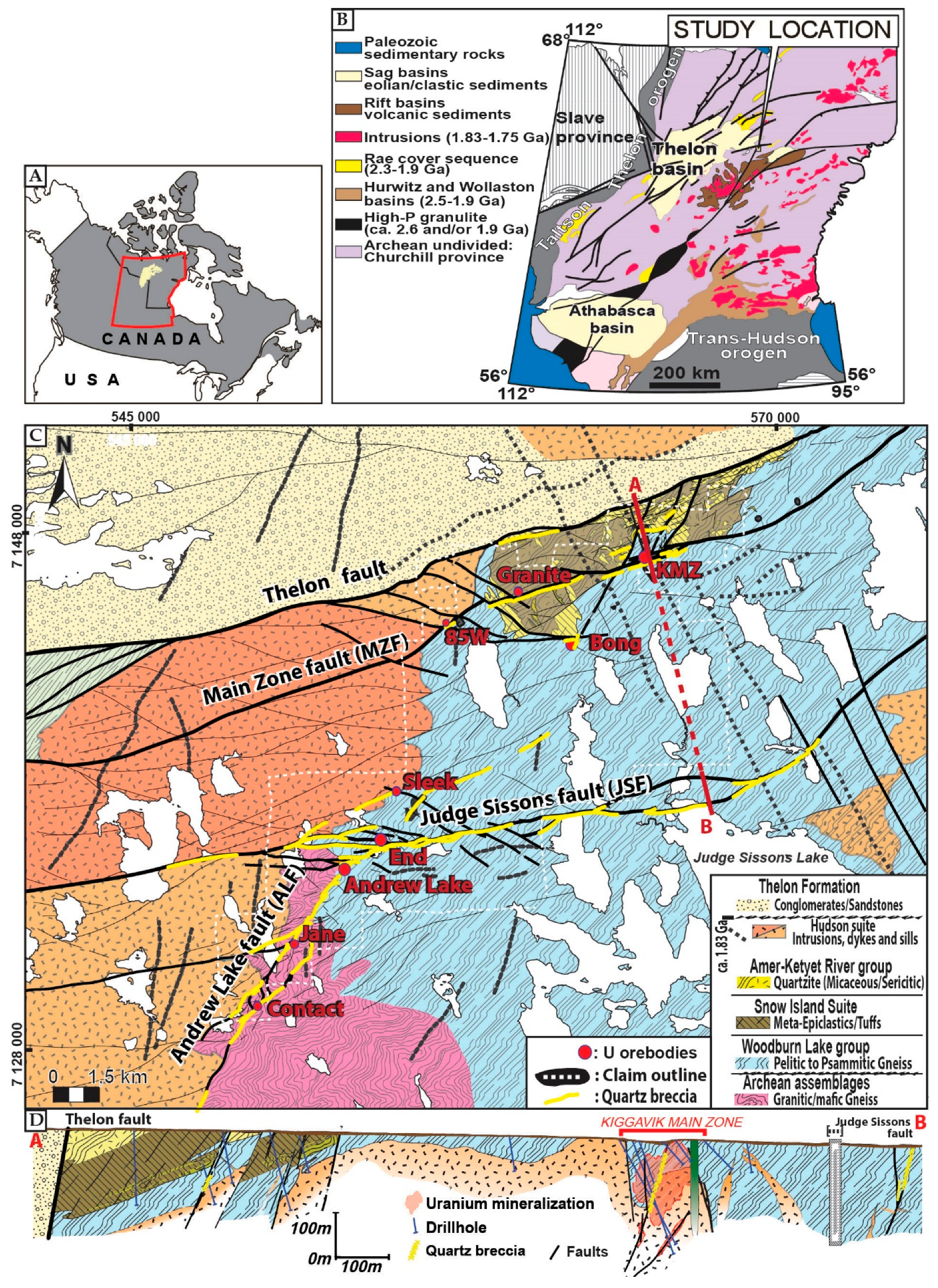
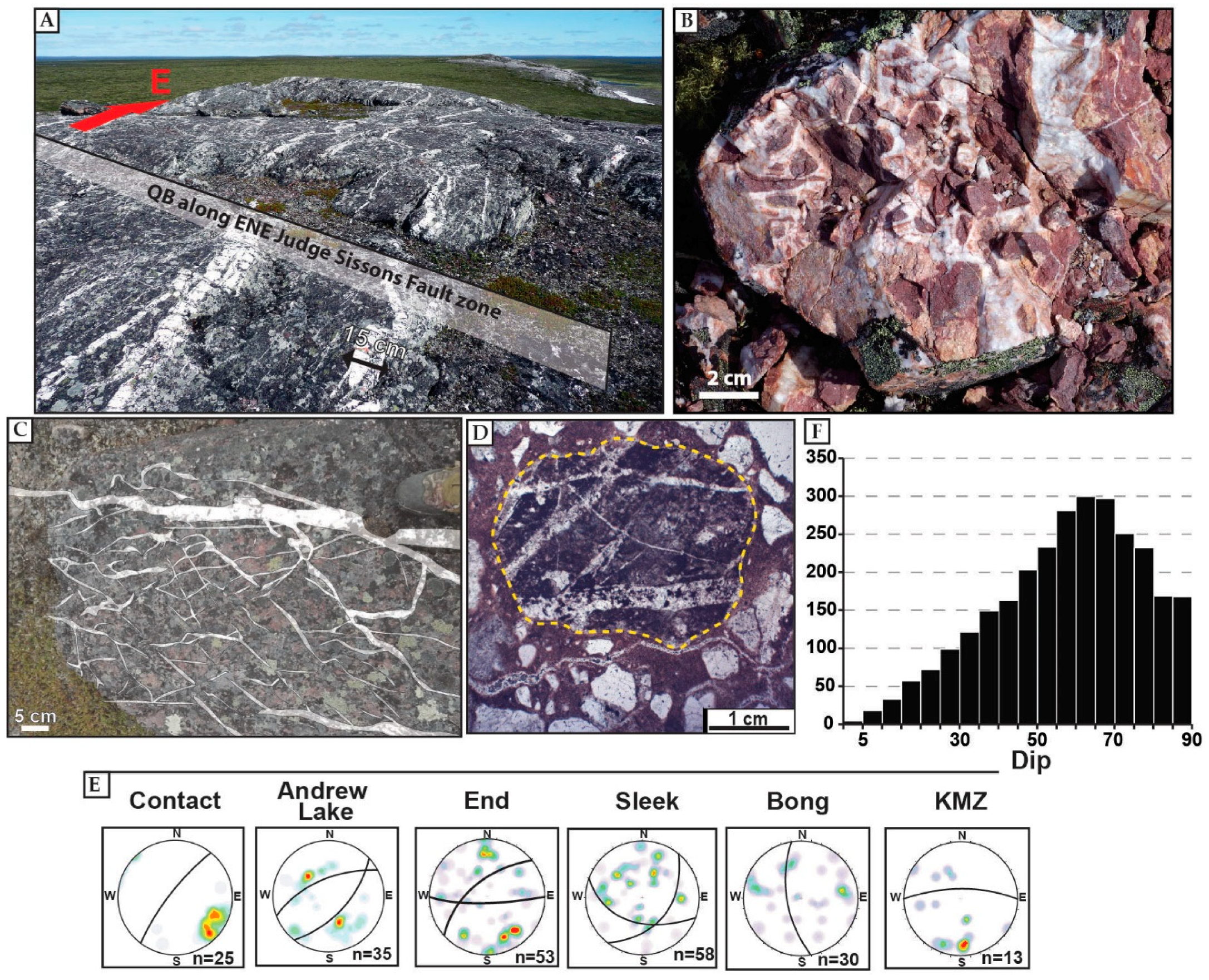
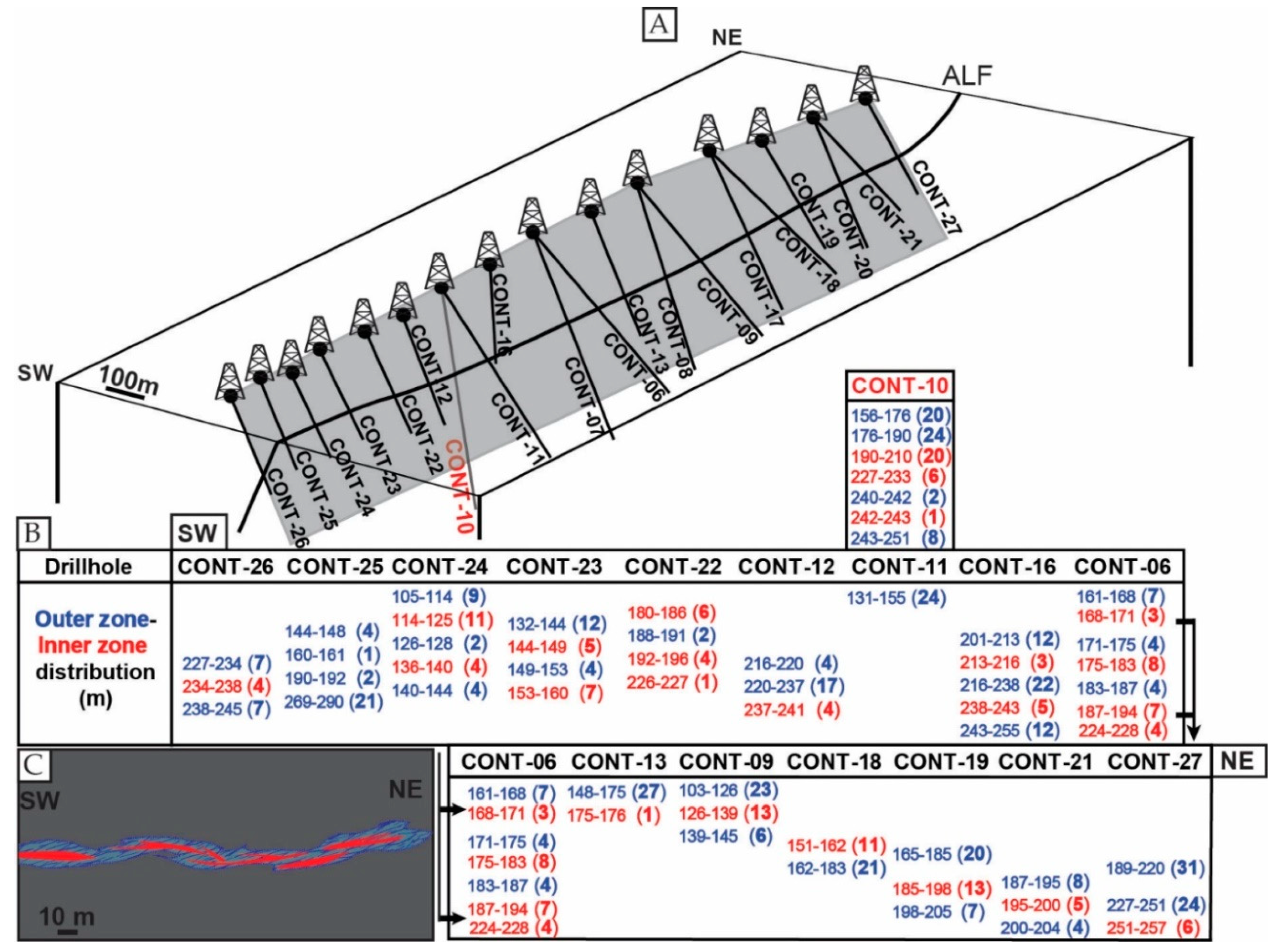

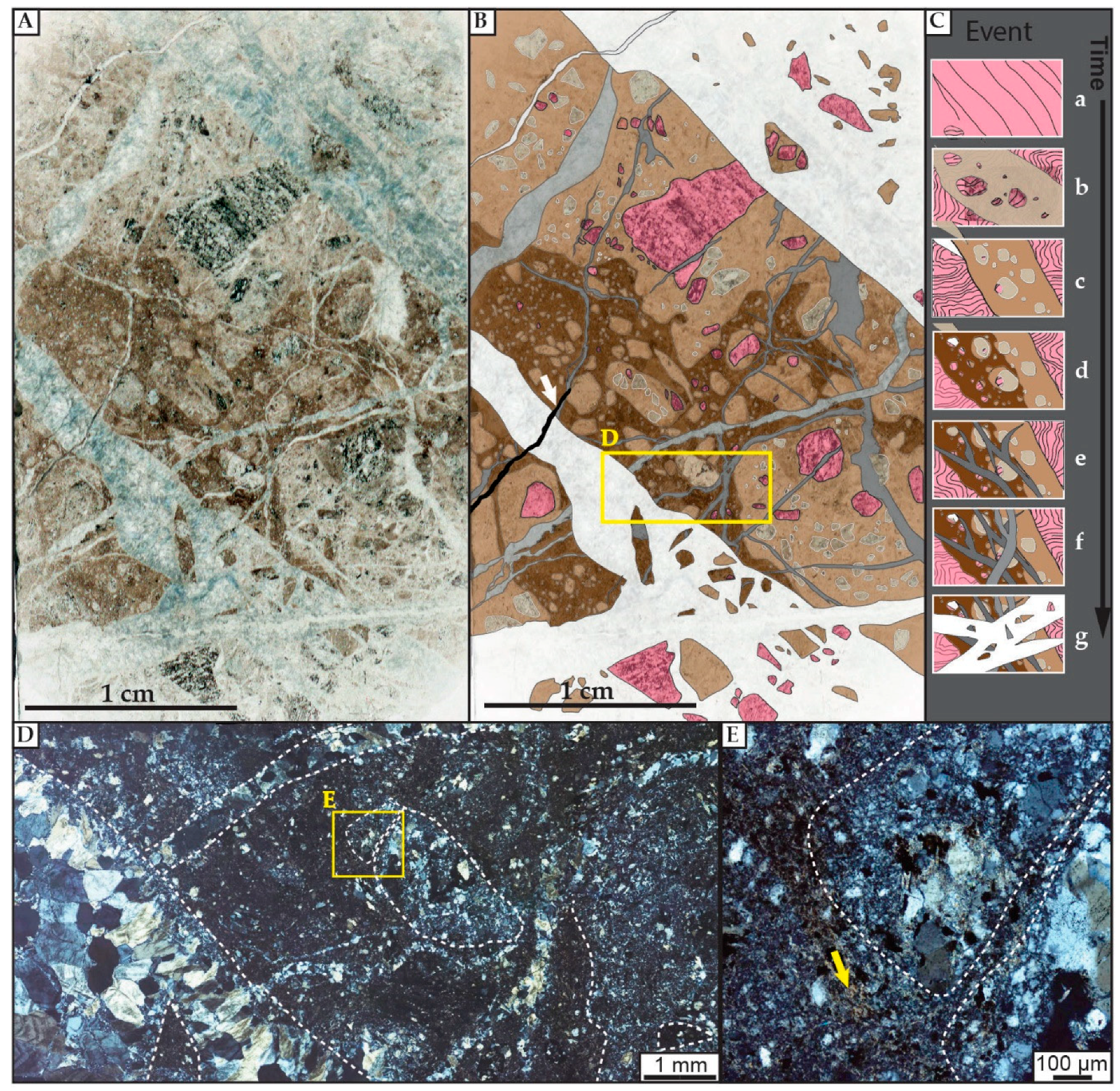

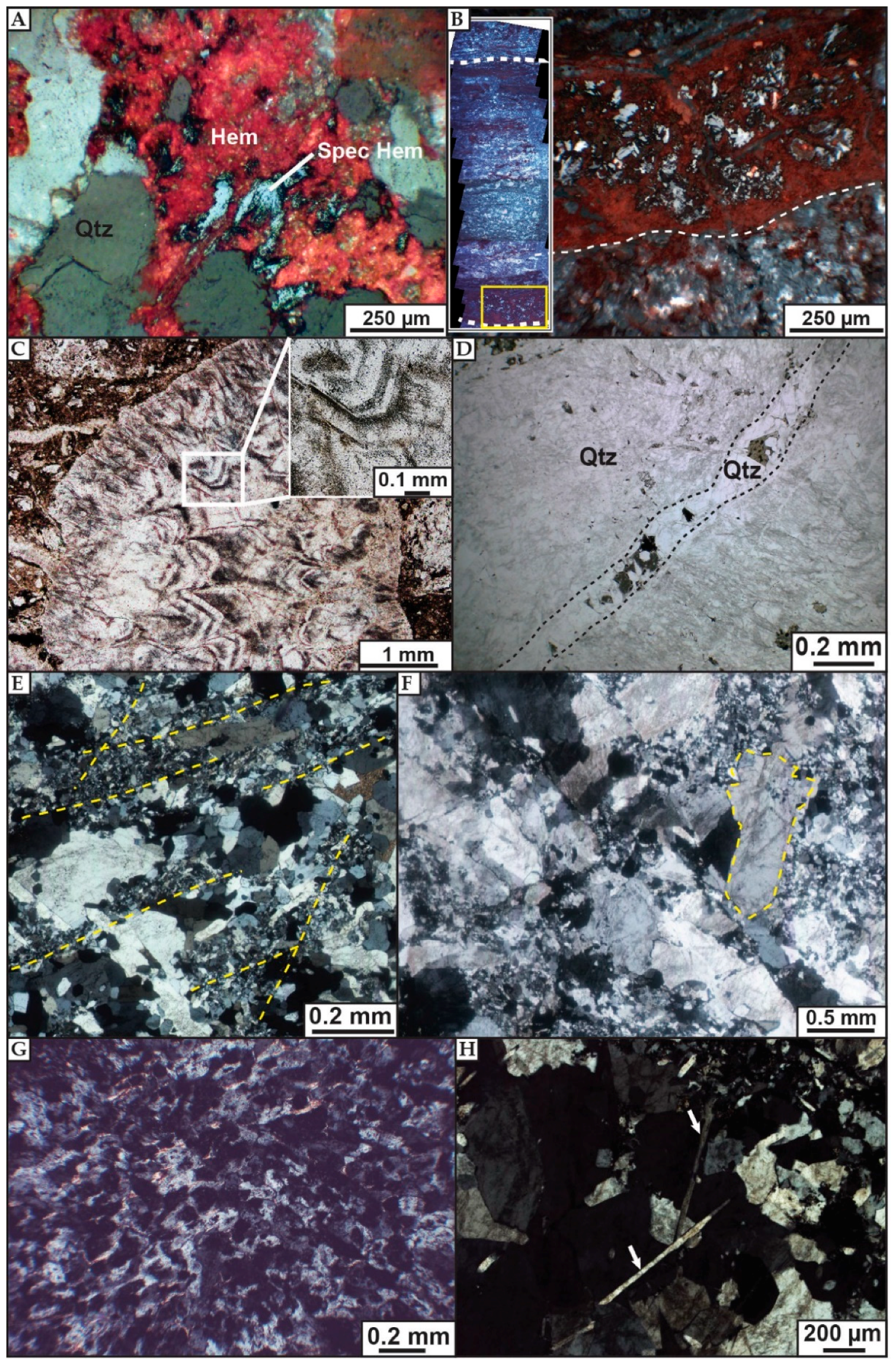
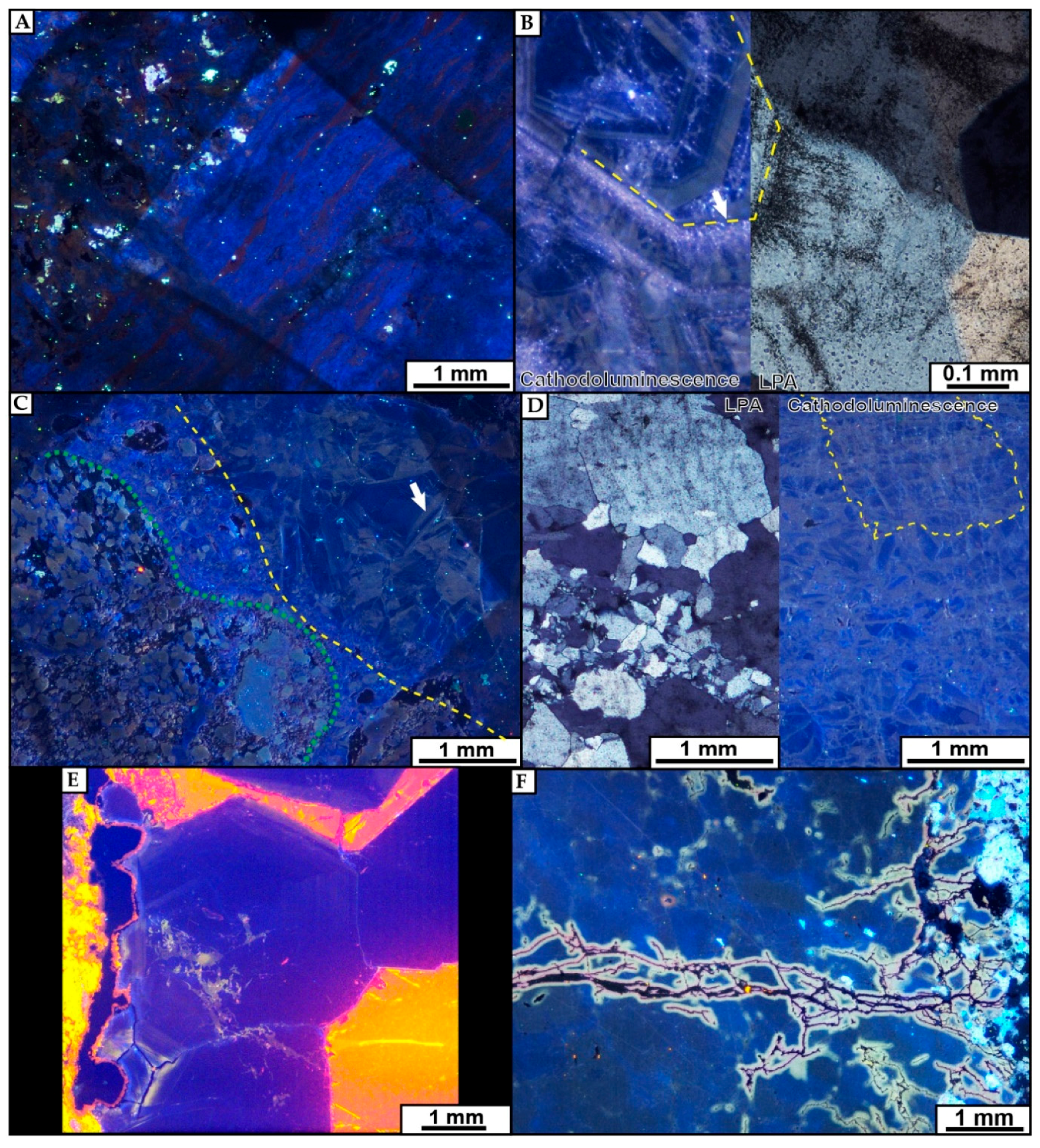


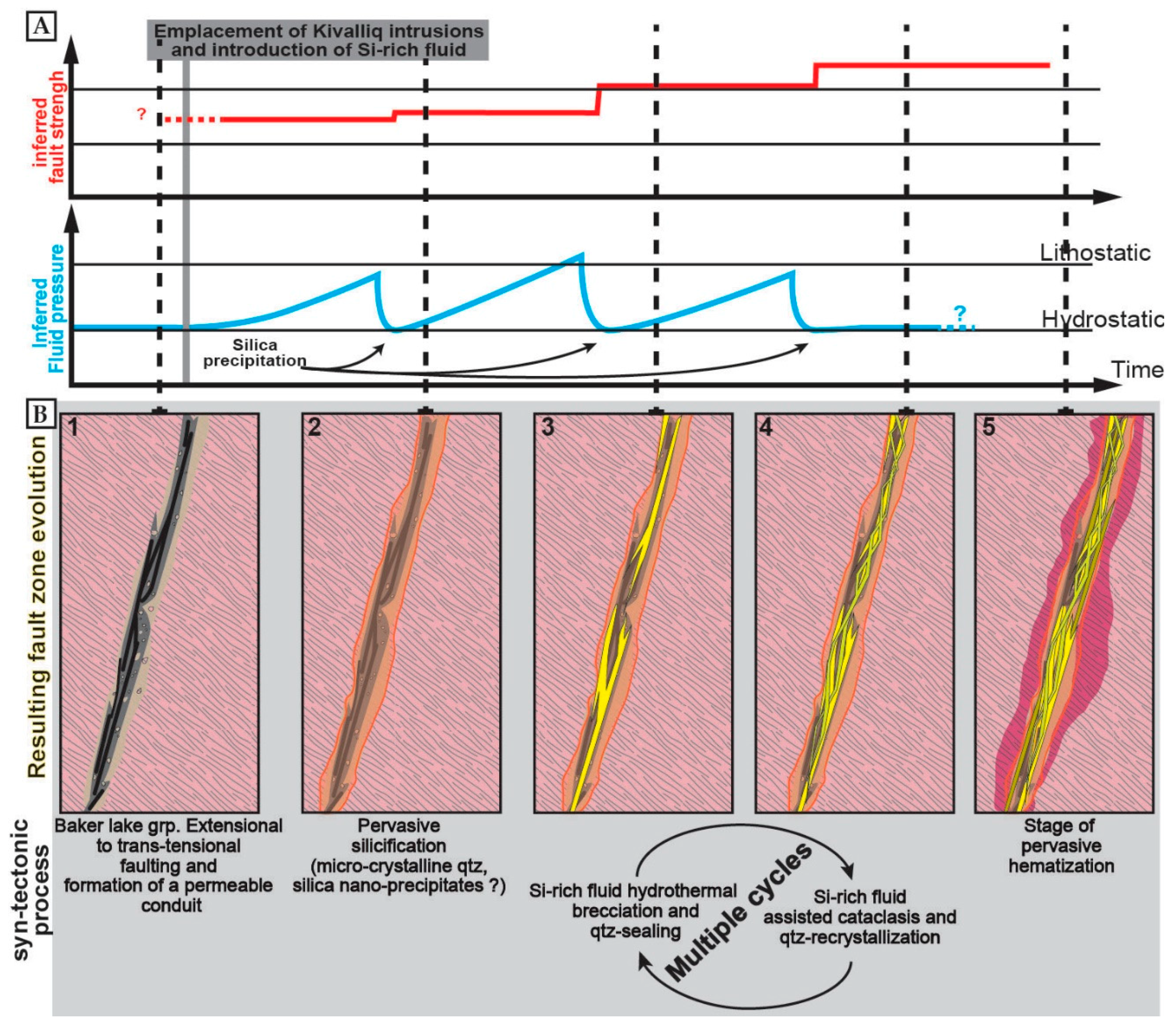
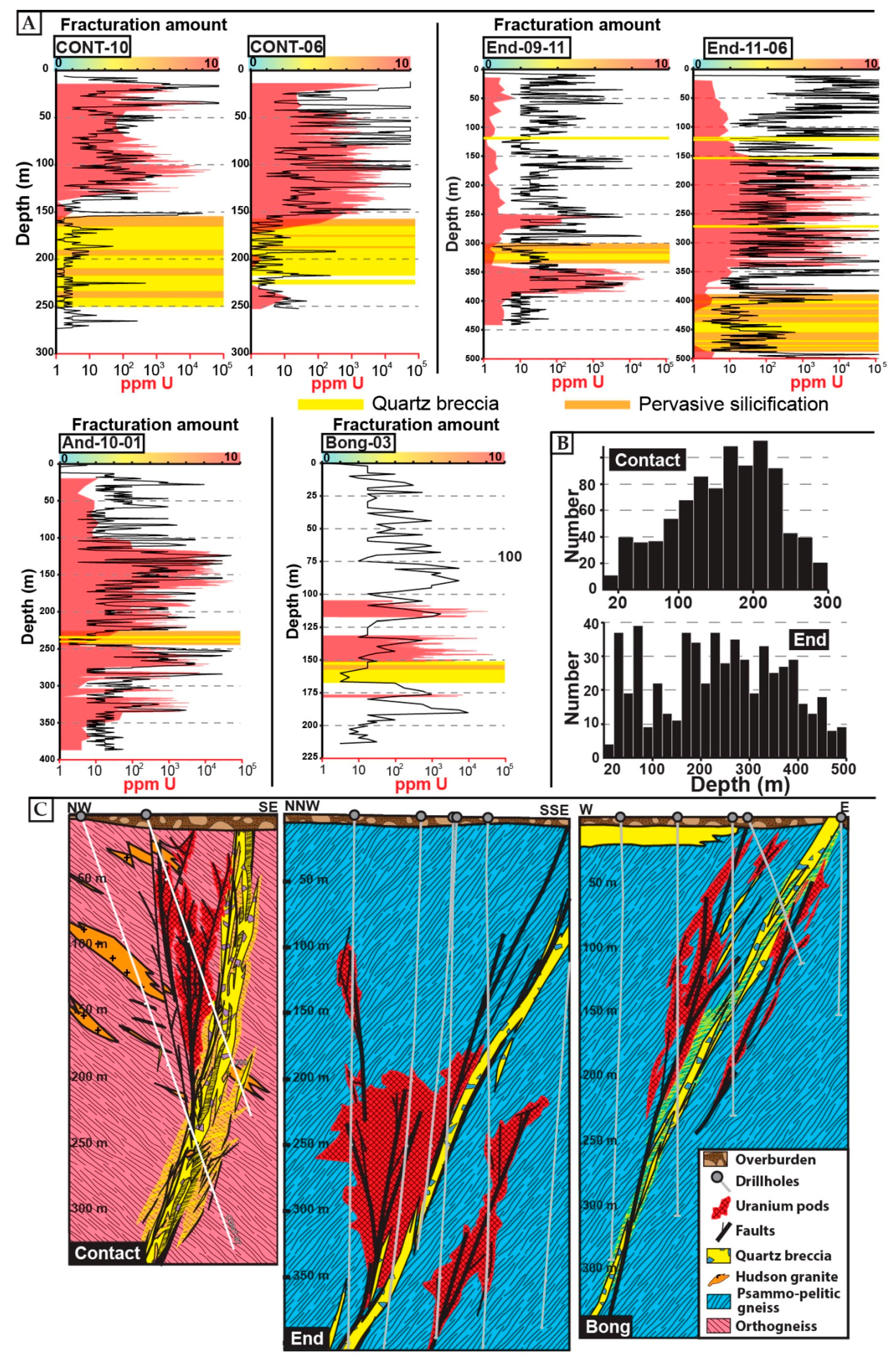

| Quartz Type | CL Luminescence Color | δ18Oquartz | Avg. | n | δ18Ofluid | Avg. |
|---|---|---|---|---|---|---|
| Banded microcrystalline quartz (alternated with iron oxides) | Deep blue | 12.0–14.0 | 12.9 | 14 | 2.4–5.3 | 3.9 |
| Euhedral quartz with concentric zoning | Alternating blue and brown luminescence | 7.5–9.3 | 8.4 | 18 | −1.6–0.3 | −0.6 |
| “Late” microcrystalline quartz | Deep blue | 18.8–23.9 | 22.1 | 10 | 11.5–14.8 | 12.4 |
| Vuggy quartz | Dark blue | 14.4–15.5 | 14.9 | 29 | −5.3–2.5 | −3.3 |
| Quartz alteration associated with fluid inclusions | Green | 16.2–22.0 | 17.8 | 5 | −2.5–3.8 | −0.3 |
© 2018 by the authors. Licensee MDPI, Basel, Switzerland. This article is an open access article distributed under the terms and conditions of the Creative Commons Attribution (CC BY) license (http://creativecommons.org/licenses/by/4.0/).
Share and Cite
Grare, A.; Lacombe, O.; Mercadier, J.; Benedicto, A.; Guilcher, M.; Trave, A.; Ledru, P.; Robbins, J. Fault Zone Evolution and Development of a Structural and Hydrological Barrier: The Quartz Breccia in the Kiggavik Area (Nunavut, Canada) and Its Control on Uranium Mineralization. Minerals 2018, 8, 319. https://doi.org/10.3390/min8080319
Grare A, Lacombe O, Mercadier J, Benedicto A, Guilcher M, Trave A, Ledru P, Robbins J. Fault Zone Evolution and Development of a Structural and Hydrological Barrier: The Quartz Breccia in the Kiggavik Area (Nunavut, Canada) and Its Control on Uranium Mineralization. Minerals. 2018; 8(8):319. https://doi.org/10.3390/min8080319
Chicago/Turabian StyleGrare, Alexis, Olivier Lacombe, Julien Mercadier, Antonio Benedicto, Marie Guilcher, Anna Trave, Patrick Ledru, and John Robbins. 2018. "Fault Zone Evolution and Development of a Structural and Hydrological Barrier: The Quartz Breccia in the Kiggavik Area (Nunavut, Canada) and Its Control on Uranium Mineralization" Minerals 8, no. 8: 319. https://doi.org/10.3390/min8080319





